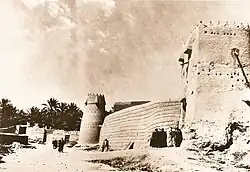Riyadh city fortifications
The Riyadh city fortifications (Arabic: سور مدينة الرياض, romanized: Sūr madīnat ar-Riyāḍ) were series of earth-structured walls with watchtowers and gates that encircled the fortress-city of Riyadh, in modern-day Saudi Arabia intermittently from 1700s until they were demolished in 1950.[1] Subsequently, Riyadh outgrew as a metropolis[2] and the area covering the perimeters of the wall was renamed as the Qasr al-Hukm District in 1973.
| Riyadh city wall | |
|---|---|
سور مدينة الرياض | |
| Part of Old Riyadh | |
 Dukhnah Gate of the old city walls, 1930s | |
| Type | Series of earth-structured defensive fortifications |
| Site history | |
| Built | 1704 |
| Built by | Daham bin Dawas al-Shalaan |
| In use | 1950 |
| Materials | Mud-brick |
| Fate | demolished |
Overview
The early origins of the wall dated back to 18th century during the reign of Riyadh's ruler Daham bin Dawas al-Shaalan and was razed and rebuilt on numerous occasions over the course of time. The wall was renovated for the last time by Ibn Saud soon after the Battle of Riyadh in 1902 before it was finally demolished in 1950 in order to pave the way for the city's expansion.[3] The wall had 9 gates, which were known as darawiz[4] (Arabic: الدراويز, romanized: al-darāwiz), the plural Arabized form of the Persian word darwazah (Persian: دروازه, romanized: darvâze), meaning gateway.
History

Historical accounts largely credit Riyadh's 18th century ruler Daham bin Dawas al-Shalaan for being the first one to erect a wall around Riyadh in around 1704.[5] After expelling the Ottoman-backed Egyptian forces from Najd and reinstating the Second Saudi State in 1824, Imam Turki al-Saud ordered the reconstruction of Daham's walls.[6] However, after the victory of the Rashidi dynasty in the Battle of Mulayda against the House of Saud in 1891, the new ruler of Najd Ibn Rashid went on to desecrate and destroy much of al-Saud's structures, including the Riyadh wall.[7] After Ibn Saud deposed the Rashidis in 1902 after the Battle of Riyadh, he ordered the rehabilitation of the wall in order to safeguard the city from trespassers and invaders and was demolished nearly four decades later in 1950 when Riyadh underwent modernization and expansion.[3]
Gates
The Riyadh city wall had around 10 gates and 20 watchtowers.[8]
- Bab al-Thumairi
- Bab al-Guraiy
- Bab al-Musada
- Bab al-Badiah
- Bab al-Suwailem
- Bab al-Duhaira Gate (Bab al-Shamsiyyah)
- Bab al-Dakhna (Darwaza al-Kabirah)
- Bab al-Arair
- Bab al Muraighib
Settlements and landmarks that fell within the walls
The following were within the walls:
- Al-Duhairah settlement
- Al-Daho settlement
- Al-Ajnab settlement
- Al-Gadimah settlement
- Qasr al-Hukm
- Masmak citadel
- The Grand Mosque
- Mueqilia settlement
- Al-Muqbiriah settlement
- Al-Ghanaiy settlement
- Sharqiya settlement
- Dakhna settlement
References
- "المعالم الأثرية في بلدة الرياض". www.al-jazirah.com. Retrieved 2022-07-26.
- al-Miṣrīyah, Jamʻīyah al-Jughrāfīyah (1965). Bulletin de la Société de Géographie d'Égypte.
- "تراث الرياض العمراني المفقود.. وما يمكن إنقاذه ! (1-2)". www.al-jazirah.com (in Arabic). Archived from the original on 2019-07-11. Retrieved 2022-05-19.
- "بوابات وسور الرياض التاريخية في ذكرى اليوم الوطني 89 | مجلة سيدتي". www.sayidaty.net (in Arabic). Retrieved 2022-05-19.
- الشاطري, منصور بن مروي (2013-01-01). أمير الرياض دهام بن دواس 1151 - 1187 هـ - 1738 - 1773 م (in Arabic). Al Manhal. ISBN 9796500163949.
- Ruwayshid, ʻAbd al-Raḥmān ibn Sulaymān (1992). قصر الحكم في الرياض: أصالة الماضي و روعة الحاضر (in Arabic). s.n.]،.
- mariam (2020-02-06). "إحياء سور وبوابات مدينة الرياض". الهيئة الملكية لمدينة الرياض (in Arabic). Retrieved 2022-05-21.
- التميمي, مهنا (30 May 2019). "#من_ذاكرة_السعودية.. بوابات الرياض القديمة: أسوار من الطين المجفَّف.. وأبراج حراسة دائرية تُغلق ليلاً". صحيفة سبق الالكترونية (in Arabic). Retrieved 2023-01-21.